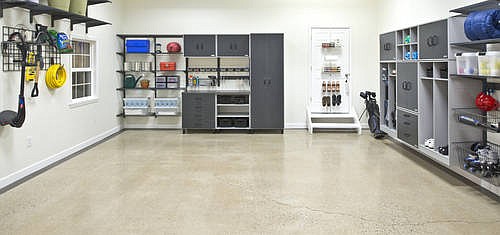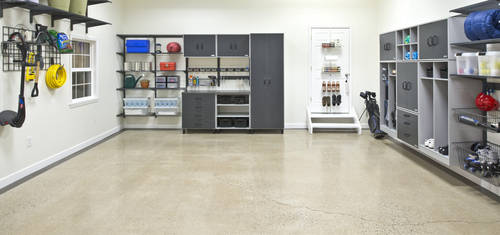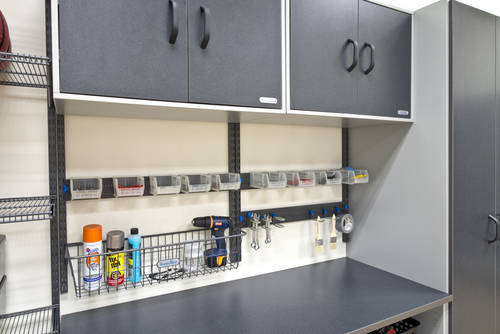Garage Guidance
Kim Campbell, owner of Chattanooga Closet, and the Lehigh Group, which makes Crawford-brand garage and home workshop organization products, have some tips for tackling the mess in your garag.Sort the messSeparate items into categories such as auto supplies, lawn and garden tools, holiday decorations, and sports equipment. Then, pitch, donate or sell items you don’t use. Before organizing and storing, take a multipurpose push broom to sweep the garage floor, or wash down the floor with a water hose.Zone it outAfter deciding what stays, separate the garage into zones for storing each category of items, and then identify the most appropriate storage method.Go verticalOne great storage strategy is to use the vertical plane to keep the floor free of clutter. Garages provide ample wall and ceiling space that can easily be used for vertical storage through use of hanging shelves, pegboards, storing rails and overhead systems. Flexible mesh storage products that hang on the wall are particularly suited to accommodate awkward items, from pet toys and work gloves to tennis balls.Be an organized sportEstablish a solid game plan to organize the typical mass of sports gear as well as the family’s fleet of bikes. For bicycles, cost-effective screw-in hooks and flip-up bike hangers, along with pulleys, are ideal ways to keep bikes off the ground and out of the way while they’re not in use.Securely store hazardous itemsPlace toxic materials such as paint, paint thinner, weed and bug killers, fertilizer and gasoline in high cabinets or lockable tool chests to keep out of the reach of children. Use well-supported shelves to store cleaning solutions and vehicle fluids. Be sure to secure tools and wrap up extension cords via tool hangers.
There is good news and some not-so-good news when it comes to organizing your garage.
First the good; according to Kim Campbell, owner of Chattanooga Closet, there are any number of new products available to help you store everything from car-detailing tools to hunting or sporting or lawncare equipment. The pieces are easy to install, heavy duty and not terribly expensive, she says. And there are companies out there like Chattanooga Closet that can help you.
The challenge - aka the not-so-good news - is that "you still have the hard work to do. You have to sort it and clean it," Campbell says.
Sure, you can hire a neighbor's kid to do that for you, but either way, somebody has to do it.
According to a survey by the Lehigh Group, which makes Crawford-brand garage and home workshop organization products, the garage is the least organized space in the home. In the survey, 42 percent of Americans admit to having never cleaned their garage or doing so once a year or less.
As part of the survey, it offered consumers tips on getting organized. It suggests creating dedicated areas for items, and making sure that the things you use most often are most accessible. It also says to think vertically with cabinets, hooks, magnetic strips and shelving, something Campbell agrees with.
Campbell's company offers storage and organization options for kitchens, closets, baths and garages. Do-it-yourselfers can buy everything you need at big-box stores, or you can hire someone like Campbell to install the equipment and help you plan and design the system.
"We do everything from $200 makeovers to $65,000 ones," she says.
If you're going to do it yourself, figure on it being a big job, probably more than a day if you've got a garage stuffed with stuff. If the job seems overwhelming, start with just the floor, Joanna M. Quandt, a professional organizer in Ohio, told the Akron Beacon Journal.
The key, Campbell says, is to assess what you have and what you want to keep - yes, you'll probably need to throw things away if you truly want to reduce the clutter and get into true organization. It's important to keep only what you need and either donate or throw away the stuff you no longer use, she says.
"If it's broken, get rid of it," she says.
Part of the assessment process also includes figuring out how you want to use the space, Campbell says, and that's where the sorting comes in. What you keep and what you toss may depend on where you are in life. Families with young kids might need places to store basketballs, bikes, skateboards and other outdoor toys and equipment. That changes when the kids grow up and move out.
"You might have a need for storing and quickly accessing car-detailing materials," she says. "Or maybe lawn equipment. Do you need a flat workspace? Are you a hobbyist? The important thing is to be able to get to what you need and to have a place to return when you are finished."
And we haven't even mentioned the option of using the space for what it was originally designed for - a place to keep the car out of the weather - but who actually uses a garage for that?
Actually, you can organize your garage and have your auto, too.
"There are some really smart divider-grid storage designs that have new ways of putting rakes and weedeaters against the wall as flat as possible so that you can actually get at least one car in there," Campbell says.
Contact Barry Courter at bcourter@timesfreepress.com or 423-757-6354.


